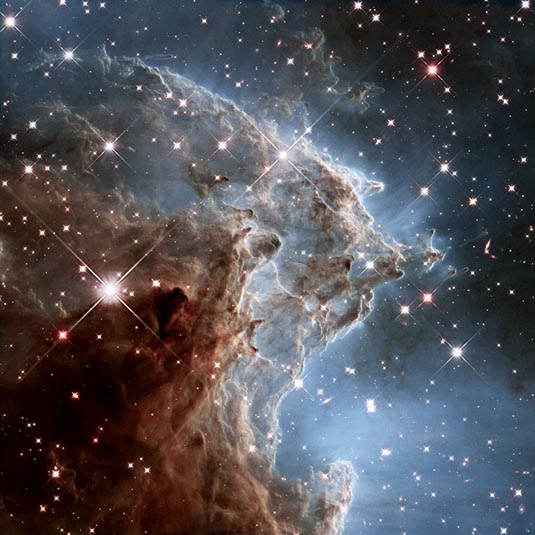
for a 24th Birthday Snapshot
Star-forming Region
R.A. 06h 09m 10s Dec. +20° 27' 20"
Orion
6,400 light-years (2,000 parsecs)
WFC3/IR
February 7 - 24, 2014
NASA, ESA, and the Hubble Heritage Team (STScI/AURA)
March 17, 2014
2011 Image: N1106
ABOUT THIS IMAGE:
In celebration of the 24th anniversary of the launch of NASA's Hubble Space Telescope (on April 24, 1990) astronomers have taken an infrared-light portrait of a roiling region of starbirth located 6,400 light-years away.
The Hubble mosaic unveils a collection of carved knots of gas and dust in a small portion of the Monkey Head Nebula (also known as NGC 2174 and Sharpless Sh2-252). The nebula is a star-forming region that hosts dusky dust clouds silhouetted against glowing gas.
Massive,
newly formed stars near the center of the nebula (and toward the right
in this image) are blasting away at dust within the nebula. Ultraviolet
light from these bright stars helps carve the dust into giant pillars.
The nebula is mostly composed of hydrogen gas, which becomes ionized by
the ultraviolet radiation. As the interstellar dust particles are warmed
from the radiation from the stars in the center of the nebula, they heat
up and begin to glow at infrared wavelengths.
NGC 2174 is not too far from the Orion-Gemini constellation border. NGC
2174 is similar in size and shape to the Great Orion Nebula. At 6,400
light-years distant, however, it resides nearly 6 times farther away than
the Orion Nebula.
The composite image is a collection of individual infrared filters that
each let in a slightly different wavelength of light from the electromagnetic
spectrum. As the interstellar dust particles are warmed from the radiation
from the stars in the center of the nebula, they heat up and begin to
glow at infrared wavelengths. Observations of NGC 2174 were taken in Feburary,
2014.
From the ESA release:
To celebrate its 24th year in orbit, the NASA/ESA Hubble Space Telescope
has released a beautiful new image of part of NGC 2174, also known as
the Monkey Head Nebula. This colorful region is filled with young stars
embedded within bright wisps of cosmic gas and dust. NGC 2174 lies about
6400 light-years away in the constellation of Orion (The Hunter). Hubble
previously viewed this part of the sky back in 2001, creating a stunning
image released in 2011, and the space telescope has now revisited the
region to celebrate its 24th year of operation.
Nebulae are a favorite target for Hubble. Their colorful plumes of gas
and fiery bright stars create ethereally beautiful pictures. Some of the
most famous of Hubble's images have been of nebulae - for example, the
telescope's 22nd and 23rd anniversary images of the Tarantula (N1105)
and Horsehead (N1312)
nebulae, and its festive 2012 image of planetary nebula NGC 5189 (N1249.).
The detail shown in this image lies within NGC 2174, a nebula which gets
its more common name, the Monkey Head Nebula, from its curiously familiar
shape when viewed in wide-field images. The nebula is a violent stellar
nursery, packed with the ingredients needed for star formation. However,
the recipe for cooking up new stars isn't very efficient and most of the
ingredients are wasted as the cloud of gas and dust disperses. This process
is accelerated by the presence of fiercely hot young stars which trigger
high velocity winds that help to blow the gas outwards.
A vibrant palette of colors can be seen in this new image of NGC 2174.
Dark brown and rust-colored dust clouds billow outwards, framed against
a background of bright blue gas. These striking hues are formed by combining
several Hubble images taken with different colored filters, to reveal
a broad range of colors not normally visible to the human eye. The icing
on this cosmic birthday cake takes the form of young white and pink stars
sprinkled amongst the glowing clouds, pushing away the dark stellar nurseries
in which they formed. The key ingredient in NGC 2174 is hydrogen gas,
which is ionized by the ultraviolet radiation emitted by the young stars.
As a result, this region is also known as an HII region [1]
- a large cloud of ionized gas.
This portion of the Monkey Head Nebula was imaged in the infrared using
Hubble's Wide Field Camera 3. Hubble's earlier Wide Field Planetary Camera
2 image from 2011 inspired its choice as the telescope's 24th anniversary
image.
Notes:
[1] An HI region (pronounced "H-one")
contains a lot of neutral hydrogen, an HII (pronounced "H-two") lots of
ionized hydrogen, and an H2 region contains molecular hydrogen
The image
demonstrates the power of the infrared capability of Hubble and offers
a tantalizing hint of what scientists can expect from the upcoming NASA/ESA
collaboration to build and launch the James Webb Space Telescope.
Colors:
This composite image includes exposures acquired by the WFC3 instruments
on the Hubble Space Telescope. Several filters were used to sample broad
wavelength ranges. The color results from assigning different hues (colors)
to each monochromatic (grayscale) image associated with an individual
filter. In this case, the assigned colors are:
F105W (Y)
blue F125W
(J) green F160W
(H) red